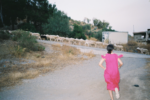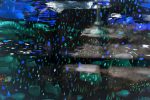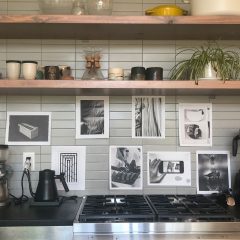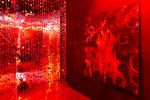“Oh crap,” I thought as I walked into the exhibition space. Immediately confronted with a painted image of fly-ridden feces, my first impression of Gahee Park’s show was harsh and uncomfortable. The show plays with the idea of a primitive modernism and as it is displayed, resembles the kind of Neolithic diorama that you would find in a very bizarre natural history museum. Entitled “Back to Nature,” Park’s work focuses on the decomposition and degradation of humankind.

Both the press release and the banner for the show presented an image depicting an apocalyptic scene of ruin: crushed bricks, battered cement and an uprooted tree. This was the first clue that Park’s show was less than conventional. Expecting to see a show of photography, I was confused by the seemingly-unrelated photo that framed the doorway to the gallery. Curator David Dempewolf explains, “The photograph sets the tone for the show.” I did not understand it at the time, but upon later reflection came to realize that the photo, like the show, had the same lonely and barren feeling. This image suggests that what you are about to see represents the breakdown and destruction of modern concepts.
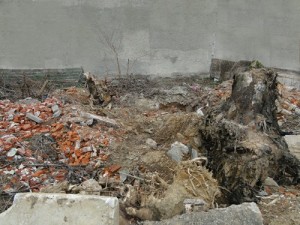
(courtesy of Marginal Utilty)
The show itself features a warm and desert-like palette but much to my annoyance, none of the pieces are titled. I like the accessibility that titles provide and feel as though their absence is a hindrance to the viewer’s understanding. Without titles, we are forced to analyze and understand the pieces based purely on the visual hints that an artist has sort-of provided. For Park, that is the point and we are left to navigate her wasteland with decomposing excrement as our only clue. The painting below features a naked, eyeball-less woman who is subtly flipping us off. It is interesting to note that unlike the historical canon of bathing nudes painted by the likes of Matisse and Renoir, this figure is not celebratory of the female form. Though she is in her natural state, both her and her surroundings are not beautiful. The woman bathes in a murky body of water that is disgusting and unsavory but just clean enough to support the lives of a woman and the verdant plant-cum-sea monster behind her. Her body language reads stiff and angry but without eyeballs, her true expression is muddled. Perhaps her mere half-living state is a testament to the impossibility of humans returning successfully “back to nature.”
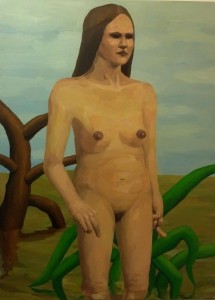
The next piece depicts two women who are semi-enclosed by a brick wall (perhaps a fragment of a once-complete building) and we look on as they feast on ants. This scene is reminiscent of one from those survival-based reality shows in which the contestants are deserted without food and are forced to sustain themselves on nature’s resources. Oddly enough, however, the body types of these women would suggest that their diet is thriving — their reversion to animalistic tendencies must be the reason why.

The bottom half of a man scurries away behind a rather scary-looking cactus in Untitled 5. Is he chasing down ants like his female neighbors? Or rather, is he hiding from a predator? I like to think that in this instance, the viewer is the predator. We stand before him ready and with teeth gnashing to metaphorically dissect the prey before us. The surroundings provide little shelter for our hiding man and unlike the previous piece, what nature has provided is insufficient for survival.
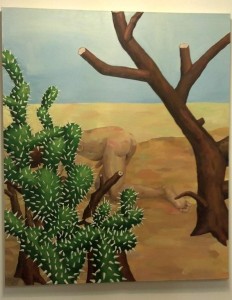
Dempewolf describes “Back to Nature” as being tongue-in-cheek, but other than the obvious nods to potty humor, it did not strongly resonate with me. Park’s point is to prove that her version of nature is, contrary to our prior beliefs, not that beautiful and perhaps that is where the irony lies. Like the natural history diorama, the artist uses figures and scenery to tell a story and while the show seemed cohesive in its style and tone, I felt as though there were too many context-providing elements missing (i.e. facial expressions, titles, etc.). That being said, if you are someone who is a fan of “Survivor” or enjoys slightly-vague and fatalistic art, perhaps this is one you might try.
“Gahee Park: Back to Nature,” to March 24. Marginal Utility, 319A N. 11th St., 2nd floor


